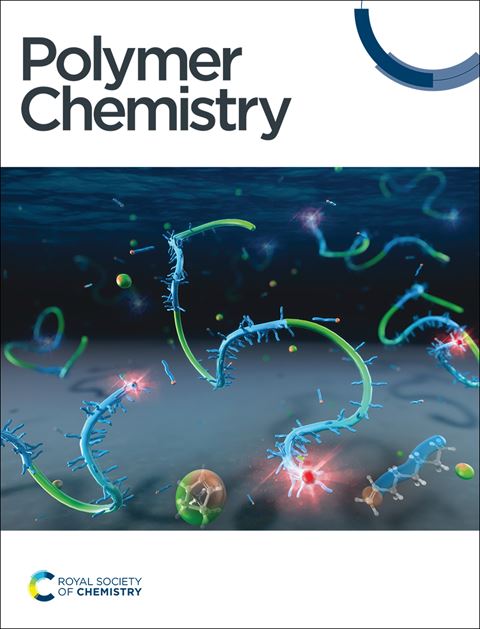通过C-H键激活单功能丙烯酸酯聚合物的交联
IF 3.9
2区 化学
Q2 POLYMER SCIENCE
引用次数: 0
摘要
交联丙烯酸聚合物因其耐久性和耐化学性而受到高度重视,使其广泛应用于各种应用和行业。通常,它们是通过添加交联剂(多功能单体或低聚物)或通过后处理工艺合成的。然而,我们的初步研究表明,即使是单功能的丙烯酸单体也可以形成交联结构。这些交联结构的形成被认为是由单体取代基和自由基之间的氢原子转移(HAT)链转移机制引起的。尽管如此,这一过程尚未被彻底分析,很少有研究将这一概念应用于聚合物网络的设计。为了阐明这一现象,我们使用10种广泛使用的单体和3种不同的光引发体系进行了一系列筛选实验,发现2 -丙烯酸羟乙酯(HEA)、4 -丙烯酸羟丁酯(HBA)和2 -[2 -(2 -甲氧基乙氧基)乙氧基]丙烯酸乙酯(MEEEA)表现出优异的交联能力。此外,量子化学计算被用来阐明为什么这些特定的单体在形成交联网络方面表现优异。假设扩展的丙烯基自由基作为HAT的氢受体,发现在MEEEA取代基上以及HEA和HBA氢键条件下发生的反应是热力学稳定的。因此,由单官能丙烯酸酯形成的交联结构被确定是由于在单体取代基上产生的自由基。这种增强的理解为交联聚合物的合成提供了一个新的范例,扩大了它们在不同应用中的潜力。本文章由计算机程序翻译,如有差异,请以英文原文为准。
Crosslinking of polymers from monofunctional acrylates via C–H bond activation†
Cross-linked acrylic polymers are highly valued for their durability and chemical resistance, making them extensively used in various applications and industries. Typically, they are synthesized by adding crosslinkers (multifunctional monomers or oligomers) or through post-treatment processes. However, our preliminary studies indicated that even monofunctional acrylic monomers can form cross-linked structures. The formation of these cross-linked structures is thought to result from a chain transfer mechanism involving hydrogen atom transfer (HAT) between monomer substituents and radicals. Despite this, the process has not been thoroughly analyzed, and few studies have applied this concept to the design of polymer networks. To clarify this phenomenon, we conducted a series of screening experiments using ten widely-used monomers and three different photoinitiation systems, discovering that 2-hydroxyethyl acrylate (HEA), 4-hydroxybutyl acrylate (HBA), and 2-[2-(2-methoxyethoxy)ethoxy]ethyl acrylate (MEEEA) exhibited superior crosslinking capabilities. Furthermore, quantum chemical calculations were employed to elucidate why these specific monomers excel in forming cross-linked networks. Assuming the propagating acryl radical acts as the hydrogen acceptor for HAT, it was found that the reactions occurring in the substituents of MEEEA and under hydrogen bonding conditions in HEA and HBA are thermodynamically stable. Consequently, the cross-linked structures formed by monofunctional acrylates were determined to be due to radicals generated at the substituents of the monomers. This enhanced understanding offers a new paradigm in the synthesis of cross-linked polymers, expanding their potential across diverse applications.
求助全文
通过发布文献求助,成功后即可免费获取论文全文。
去求助
来源期刊

Polymer Chemistry
POLYMER SCIENCE-
CiteScore
8.60
自引率
8.70%
发文量
535
审稿时长
1.7 months
期刊介绍:
Polymer Chemistry welcomes submissions in all areas of polymer science that have a strong focus on macromolecular chemistry. Manuscripts may cover a broad range of fields, yet no direct application focus is required.
 求助内容:
求助内容: 应助结果提醒方式:
应助结果提醒方式:


